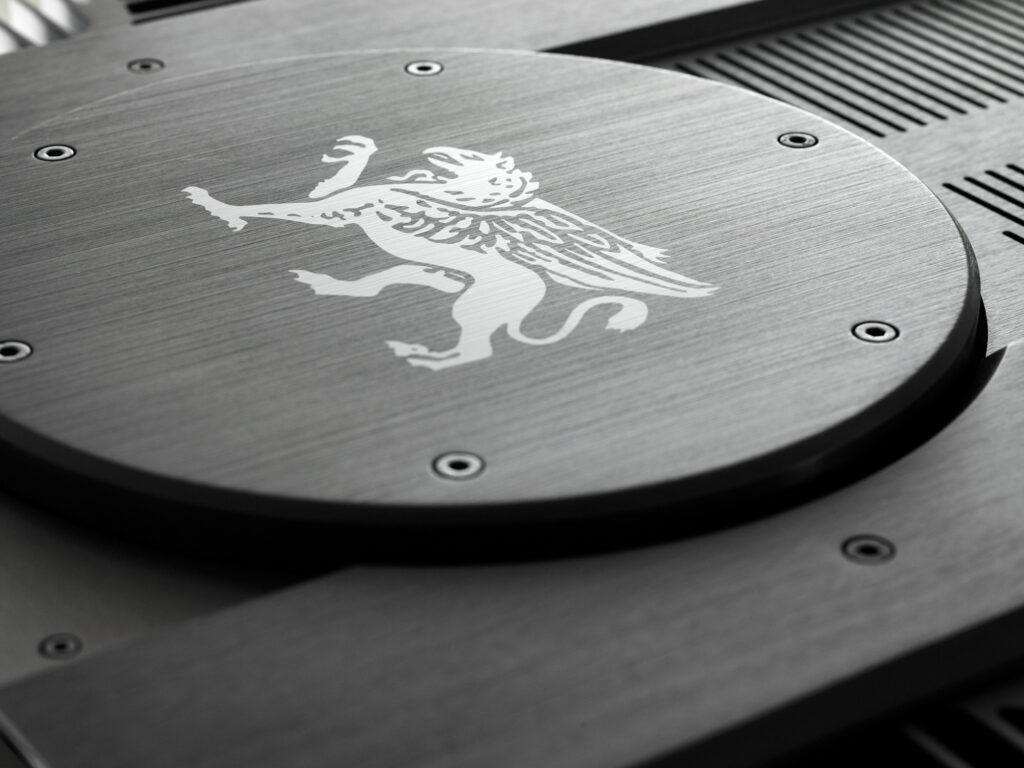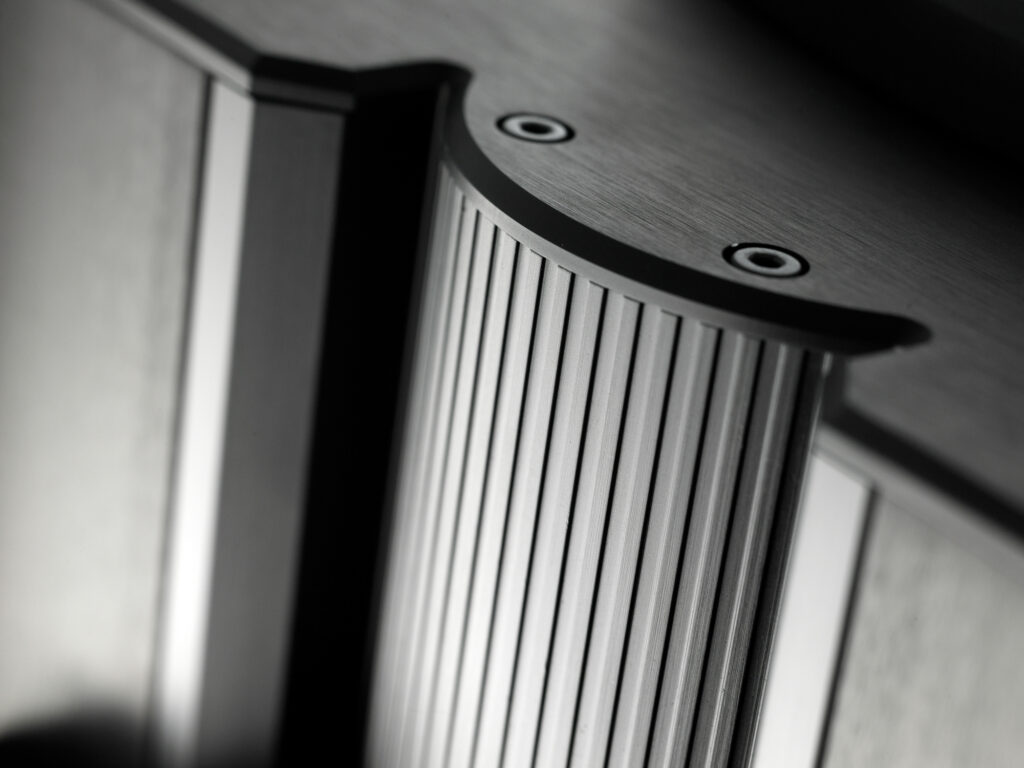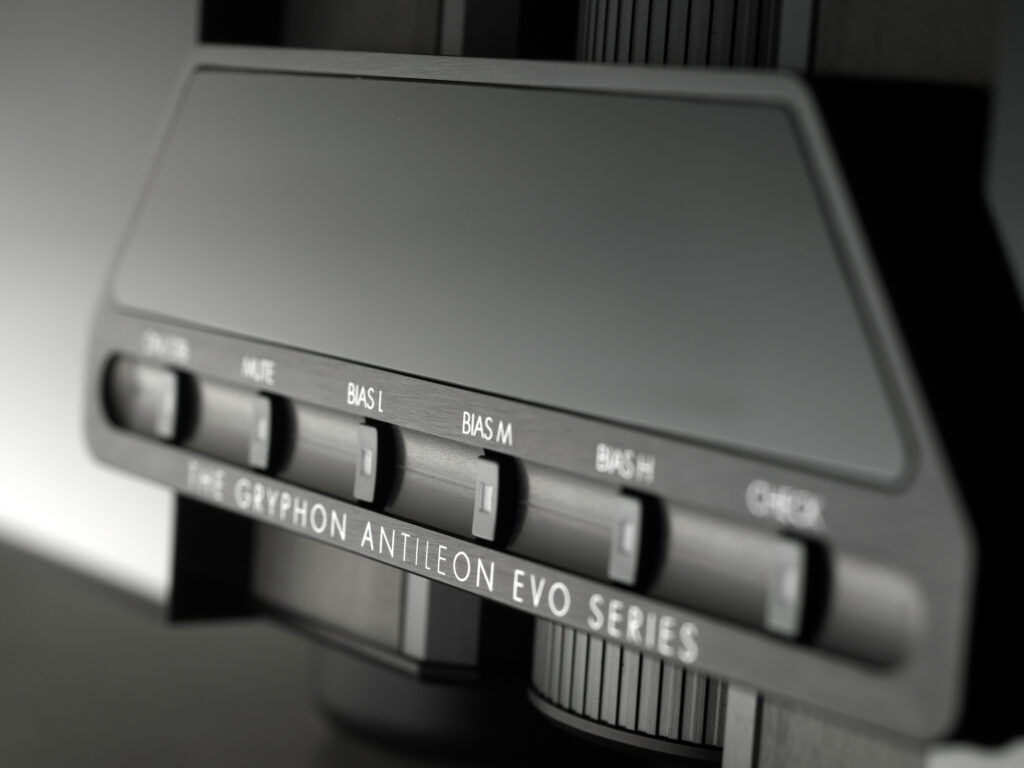The sound
The Gryphon Antileon Evo is one of the least expensive of Gryphon’s power amp offerings, the new 22,200 USD Essence pure class A stereo at 50 wpc being the lowest priced, but you couldn’t tell that by its sound, which is smooth as silk but extremely detailed while producing a gigantic soundstage and truly prodigious bass. My immediate reaction during the first few minutes of my home listening session was, “Why the hell did I wait so long to try this amp?”
Starting with the basics, the Evo is extremely quiet. I am regularly surprised about how many high end amps have transformer buzz or hum. Quite frankly, it drives me bonkers. A few years ago, I had to obtain two Emotiva CMX-2 with their Precision Common Mode AC Line Filter With DC Offset Eliminator in order to review $30,000 monoblocks that buzzed loudly when plugged directly into the wall. Given the vagaries of the AC supply in many places, I would expect a designer to anticipate what needs to be done to prevent such issues in a home listening environment. Similarly, I am bothered to no end by thumps, clicks and thuds that occur during turn on, turn off, and anything in between.There are absolutely no such irritating issues with the Evo. The build quality, attention to detail, and the obvious expertise that went into this amp are impeccable in every respect.
Moving next to the bigger sonic picture, one major characteristic of the Evo’s sound is just how natural and “real” it is. OK, I get it. You’re saying, “What kind of crap is this pompous reviewer spouting? It might sound good, but we all know it’s not ‘real’!” Let me illustrate.
On the classical side, one of my favorite musical pieces to play on cold windy days in winter is Tchaikovsky’s Symphony 1 in G Minor, op.13 — “Daydreams on a Wintry Road: Allegro Tranquillo.” In my opinion, the ability to accurately replicate the music’s dynamic range and emotive texture are the two factors that elevate performances of this music beyond “merely” excellent to sublime. I had the benefit of hearing the Chicago Symphony perform this in Symphony Hall, so I have an excellent reference point. Before going to Symphony Hall that day, I listened to a Deutsche Grammophon recording of this piece by Michael Tilson Thomas conducting the Boston Symphony. Listening to that recording attuned my ears to the instruments employed, as well as to the overall presentation of the music. Over the next several days, I played this recording multiple times on my pre-Antileon Evo system and marveled at how good it sounded. As a result, I was unprepared for the treat I had when I first played the recording with the Evo providing amplification. Not only were the instruments clearly delineated and tonally accurate, the differences between Chicago’s Symphony Hall and Boston’s Symphony Hall could be readily discerned. I had not been able to do that previously; in fact, I didn’t even think to make the comparison. It felt like I was there. Very impressive.
Another example is Cecile McLorin Salvant’s “You Bring Out the Savage In Me” from Woman Child. If you haven’t listened to this album you need to make time to do so. I could have picked virtually any tune from this album, but settled on “You Bring Out The Savage In Me.” In addition to McLorin Salvant’s absolutely, insanely virtuoso vocals, this song has some nifty percussion sequences as well as other subtleties that make it a great listen on a good system. Again, the performers’ presence was palpable (sorry for the alliteration, but I like it), the pace, rhythm and timing was spot on, and instrument tonality very authentic.
Of course, since I listen to Rock 75% of the time, comparisons playing rock music are mandatory. Take Lou Reed’s “Walk on the Wild Side.” I know that there are numerous recordings of virtuoso double bass performances, but the simple purity of the bass track is the essential foundation of this song. If there was ever any doubt about the sophistication of the Evo’s bass reproduction, this track blew it away. The tonality, decay, and extension of the lower bass line screamed “stand up double bass in my room!” Moreover, there are really two bass lines in this song: a lower double bass and higher electric bass, and sometimes the upper bass is not clearly distinguishable. With the Antileon Evo in play, the two instruments were clearly delineated in the sonic picture and properly reproduced, with the performers clearly standing 15 feet in front of me playing real instruments. Similarly, the backing vocals were real performers in the room as they “walked up” toward their mikes doing the “doo-do-doo” harmony.
A few paragraphs above I described the three bias settings available on the Antileon Evo. I selected two pieces of music to use to compare the Evo’s performance in the bias M and bias H settings: Santana’s “Who Loves You” from Beyond Appearances and Patricia Barber’s “Touch of Trash” from Modern Cool. PRAT (pace, rhythm and timing) and attack are often the qualities that suffer when an amplifier is biased to produce a highly textured and melodic sound. This is particularly true of a system’s bass response. The issue is further complicated by the fact that the listener does not know which way the original recorded music was “biased.”I regularly attend concerts where the performer plays a song that I’m extremely familiar with from a recording, but which the performer plays with significantly greater or lesser pace. It’s not just a question of how long the performer takes to play the song, it’s the feel of the song: languid or extremely energetic. Santana’s album Beyond Appearances contains some of the most highly energetic music in his extensive catalog. “Who Loves You” is a tune that explodes from the speakers, especially when played at realistic concert levels. Playing this tune with the Evo in the Bias M setting really conveys this explosiveness to the nth degree. Putting the Evo in the Bias H setting results in a more textured bass line and realistic kick drum, but I thought I detected a very slight reduction in the sense of explosiveness of the music, although even now after several months of listening I’m happy either way. On the other hand, putting Patricia Barber’s “Touch of Trash” in play with the Bias H setting resulted in a gloriously rich musical palette, which is exactly how she sounds live. Where I thought I heard all the nuance available in the recording while in the M setting, switching to H really upped the ante. I completely stopped listening analytically and immersed myself into the total experience. The thoughtfulness that went into this amplifier’s bias options deserves high praise.
Finally, I hadn’t listened to Roxy Music’s Avalon in a long time, and I had a hankering for its combination of luscious melodies and syncopated sophistication. I decided to listen to the whole album straight through and to focus on its overall gestalt. The combined qualities of the Antileon Evo really elevated my enjoyment of this album to a whole new level. First, Bryan Ferry’s tremolo voice has never sounded so intimate, expressive and vibrant as it was through the Evo set to Bias H. Second, the bass and drums have never sounded as in-my-room realistic. I could readily envision not just percussion placement, but feel the power of even the quieter bass guitar passages. And finally, the backing vocals and sax were the most tonally accurate I’ve encountered. Just breathtaking.
In my judgement, Gryphon has created the perfect balance of amplifier qualities: detail, finesse, speed, and effortless power. For my taste, bias setting H was the preferred setting 85% of the time, with a few occasions where intentionally abrasive tunes, all hard rock, jumped just a tad more with the Evo set to bias setting M.
Brief addendum: I obtained a pair of “The Natural” power cords from Audio Magic. These PCs are aptly named. They took the already very natural-sounding Evo and upped the ante beyond anything I expected. Review to follow.
How do they do that?
I want to close this review with something that may seem esoteric and/or undefinable: Musical Enjoyment (henceforth“ME” — yes, it’s all about ME).
How do things become more than merely the sum of their parts? You randomly pick two-three sources, preamplification, amplification, and cables, connect them, and they reproduce music. But how well they reproduce that music is a crapshoot. This can happen at virtually any expense level.
On the flip side (does anyone remember the origins of that phrase?), with good advice and patient experimentation, even very modest systems can be made to sound good. It’s always fun and a bit amusing to visit someone and make a few audio system tweaks that leave them asking “What did you do?!”
Over time I’ve concluded that the one universal requirement of any good-sounding system is above-average electrical power, good electrical cabling, and well-matched amplification. This applies whether your system is analog or digital, whether your source is a reel-to-reel, turntable, or some form of digital device, and whether your speakers require 300 wpc or 5 wpc. Too often we take power and amplification for granted, assuming that they don’t have that much to do with the final sound. The Gryphon Antileon Evo demonstrates the fallacy of this assumption. Adding the Antileon Evo to a system featuring top notch speakers, source and cables really transformed my listening experience, going beyond the list of audiophile qualities and adding an emotive realism to all music. In every listening session since acquiring the Antileon Evo I’ve found it almost impossible to be purely analytical and instead find myself immersed in the performance. What could be better?
Admittedly expensive, but superior in every respect. Highly and unreservedly recommended.
Copy editor: Dan Rubin
- ← Previous page
- (Page 2 of 2)




I am sitting here listening to mine in H. Trust me.
I’ve had my Antileon EVO for approx 4 months. Likely the last amp I’ll own. Waiting for my Gryphon Pandora preamp to arrive to take my system to the next level.
To Brain.: Hi Brain Kindly request to advice is Your Antileon EVO very hot afternoon some hours of working? How is the sound : high frequencies and bass ? Regards Charles